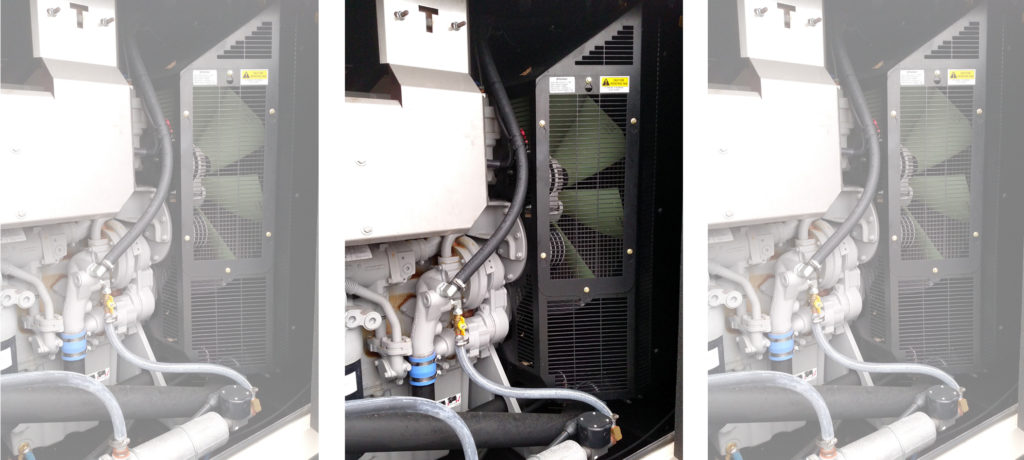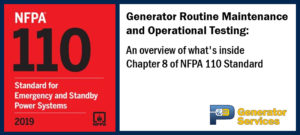The Cooling System Flush – An uninteresting topic? Think again.
This one may save you from thousands of dollars in unexpected repairs and sudden generator failure.
Radiator failures can be huge expenses that may leave your generator unusable for days while parts are ordered and repairs made. A situation that can leave any building manager nervous.
Fortunately, through proper maintenance of your generator’s cooling system these failures can be avoided.
Your time is valuable, so let’s get to what’s really important – Answering Why, When, How, and How Much?
Why is a cooling system flush necessary?
There are many benefits of having a generator’s cooling system flushed.
- Left unchecked, rust and particulate can block internal passage ways which can cause a generator to overheat. Plus, the new coolant will contain fresh additives that will protect the interior of the engine and radiator from further corrosion.
- Over time coolant properties change becoming acidic (lower pH) and corrosive to certain metal engine components. But pH levels which are too high can cause aluminum surfaces in and around the radiator to corrode and damage critical engine cooling parts. Coolant with high pH levels can ‘eat’ through the thin tubes of the radiator core causing damage beyond repair and requiring a complete radiator replacement – a repair bill that may run into thousands of dollars depending on size.
- Coolant has lubricating qualities that diminish over time. This is important in maintaining the moving parts within the cooling system, such as water pumps. Old coolant with particulate and low lubricity can cause water pumps to fail and your generator to overheat and shut down.
- Protects against foaming. Aged coolant can become frothy as it’s pumped through the system. Foamed coolant will not transfer heat away from the engine efficiently rendering the coolant ineffective and causing overheating.
When should a cooling system flush be performed?
- At least every 5 years
- When coolant pH levels are too high – high pH levels can cause corrosion and eat away at the inside tubes of the radiator causing leaking or catastrophic radiator failure – pH levels are tested during regular P3 Generator Service maintenance inspections.
- When the coolant boiling point or freezing point are out of spec – tested during regular P3 Generator Service maintenance inspections.
- Whenever the cooling system needs repair. – Repairs to coolant hoses, fittings, and other connections to the cooling system generally mean coolant must be drained first. This is a good opportunity to take advantage of the work already being done and flush the system at that time which reduces overall labor costs.
What’s the process of a Cooling System Flush?
The proper way to perform a cooling system flush is to first add a cleaning solution to the cooling system, the generator set is then run for about 15 minutes to ensure that the cleaning agents are properly circulated throughout the system. Next the system is drained of the old coolant. Fresh water is then rinsed through the cooling system and monitored until it runs out clean to ensure the removal of any remaining coolant, cleaning agents, and loose deposits. The system is then refilled with fresh coolant per engine/generator specifications.
It is additionally recommended that the thermostat and gasket be replaced during this service to ensure proper function.
How long does a cooling system flush take and how much does it cost?
There are many factors that can affect the time and cost of a cooling system flush. P3 Generator Services can provide estimates based on a case by case review. Some factors that we take into consideration are:
- Generator Size. The overall size of the generator will dictate how much new coolant will be needed and the time needed to drain, flush, and refill.
- Location. An easily accessible generator with plenty of working space will require less effort of the service technician compared to a generator tucked in a small space with limited accessibility. The generator room is not a storage closet. Remember to keep your generator room clean and free of obstacles for faster generator service.
So in the end, having the cooling system of a generator periodically maintained through proper flushing will add life to your generator, reduce overall service expenses, and potentially save your generator from failing during an emergency. And isn’t reliable emergency power why you have the generator in the first place?
For more information on this and other services designed to enhance the efficiency and life expectancy of your emergency generator power systems, contact P3 Generator Services today.
Ted Shelson
Director of Marketing
P3 Generator Services
7 Edge Road Alpha, NJ 08865
908-454-1124


